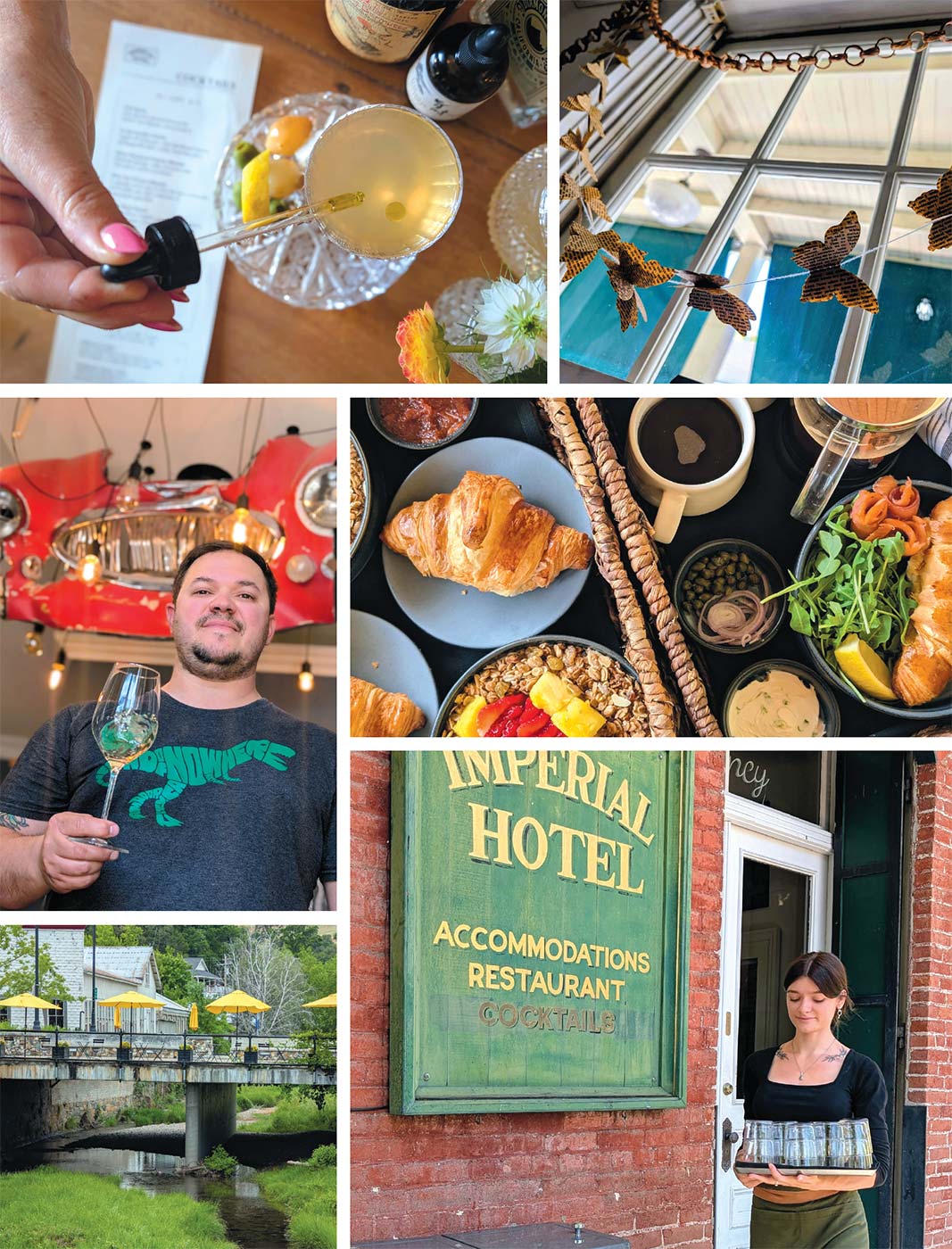
California’s tiniest town delivers big on flavor and history
PHOTOS BY MARK C. ANDERSON
Under hills dabbed with bright green oaks, wealthy California rancher Jose Maria Amador discovered gold back in 1848 on both sides of the creek in the town that now bears his name: Amador City.
That find led to the development of the Little Amador Mine, the Spring Hill Mine and, most importantly, the Keystone Mine that produced $24 million in gold and brought thousands of prospectors to the area.
These days, there are still riches to be found in this Gold Rush town that stakes the claim of being California’s smallest city in size, occupying just 3/10 of a square mile.
An under-three-hour drive from Santa Cruz, Amador City also provides a perfect weekend for those wanting to dig into California history—or just enjoy the fun and friendly food and wine establishments lined up along the town’s “main street,” which happens to be Highway 49, and about a block long.
The center of town, located at a noticeable bend in Main Street, is the two-story brick Imperial Hotel, which was constructed in 1879 after a fire tore through the town a year earlier.
The latest iteration of the longrunning establishment occurred when Kevin Carter and Cassie Davis acquired the landmark at the end of 2022. After six months of renovations and redecorating, the new Imperial Hotel opened in March 2023.
“We wanted to keep it true to the beautiful bones that the building has,” Carter says.

The hotel oozes Wild West ambiance but doesn’t lack modern amenities and comfort. The Imperial has six rooms above its bustling bar and restaurant, though we stayed a block and a half away at the hotel’s offsite cottage and its three spacious, well-appointed suites.
In a cottage on the appropriately named God’s Hill overlooking the town, the amenities include Nespresso machines, soaking tubs and a well-stocked mini-bar with unexpected items ranging from tins of mushroom-based “creativity mints” to tiny bottles of German digestif Underberg.
Dinner on our first evening revealed the Imperial’s impressive and ambitious epicurean offerings. Beverage Manager Rosie Grillo utilizes her skills and creativity to employ ingredients including mushroom bitters and a spring garden lime cordial in crafting flavorful cocktails, while the beer and wine list goes deep and includes a $120 bottle from 3 Fonteinen Brewery in Belgium.
Carter and Davis initially envisioned the restaurant going in a finedining direction but decided to change course by developing an elevated experience that appeals to both visitors and locals.
While we tasted inventive offerings including elote fries and crispy pork belly over orange cider slaw, General Manager Alyssa Luft explained how the restored hotel, restaurant and six-seat bar became a community focal point when it reopened after a nearly six-month renovation.
“We are the only business in Amador City that has a liquor license,” she says, “but the food has been the draw.”
Head Chef Becca Martinez mentions that they utilize local produce as much as possible, sourcing ingredients from the likes of Upcountry Farms, an organic farm in nearby Ione, and Gold’s Bakery, known locally for its sourdough. “We like supporting our neighbors,” she says.
A leisurely Mother’s Day brunch the next morning showcased four courses including smoked salmon carpaccio and a grilled-asparagusand- crab salad on a tangle of greens.
The Mother’s Day brunch is one of the Imperial’s special events.
They also offer quarterly wine dinners, for which they pair up with local vintners.
The foothills around Amador City became California’s first wine-producing region during the Gold Rush. The Original Grandpère Vineyard, planted in 1869, is the oldest Zinfandel vineyard in the state. Zinfandel is still produced in the region, along with Barbera, Syrah, Sangiovese and Viognier.
The place to sample wine in Amador City is The End of Nowhere, a tasting room where winemaker Chris Walsh pours natural wines that he produces nearby in his father’s former auto shop.
A local who returned to the area after 15 years of working in New York City wine bars, Walsh does unexpected takes on popular varietals—a smooth and chilled Zinfandel rosé, for instance—along with obscure wines including a slightly effervescent orange wine called Little Faith.
“If there is anything you don’t enjoy, pitch it in the creek,” Walsh said, standing on the winery’s back deck.
The names of the wines reflect Walsh’s musical tastes. “Little Faith” takes its name from a song by The National, and “Strange Currencies” honors a gem from R.E.M.’s 1994 album Monster.

When we visited The End of Nowhere, it felt like a party. DJ Ben was playing reggae records on the shaded back patio, while North Fork Feast—a barbecue and raw bar caterer from nearby Diamond Springs—served up poke bowls and tuna sliders.
On most days, Walsh is grilling up his custom-blend burgers, featuring a mix of ground chuck, American Wagyu, bison and lamb.
Walsh believes that there’s a positive and a negative to producing wine in Amador County.
“There’s a long history of producing it here,” he says, “but it’s a small, out-of-theway region.”
On weekends, Amador City’s population, which usually hovers around 200 people, grows with an influx of visitors. The Amador Whitney Museum— not related to New York City’s Whitney Museum of American Art—is located inside the oldest commercial building in Amador City.
In addition to artifacts including a safe and a church organ, the museum tells the sordid tales of individuals including Frank Fish, a local eccentric who kept caged rattlesnakes in the building and who met a suspicious death after writing the 1961 book Buried Treasure and Lost Mines.
The colorfully named Pig Turd Alley is a narrow thoroughfare that includes a bridge over a small creek along with a view of rusting mining equipment. The real treasures along the walkway are the Scottish shop Heather in the Hills and Meyer’s Antiques, with its collection of historic photos and vintage slot machines.
For our last dinner in town, we headed for Moonrise Pizza, known for its playful retro feel, mini pinball arcade and long pan pizzas.
Options include a Thai version topped with lemongrass-ginger beef, herb salad, crushed peanuts and toasted rice powder. We tried the classic pepperoni loaded with cups, and the “Sweet Baby Cheesus” starring charred onion cream, fig jam, garlic and drops of lemon ricotta.
Alania Selli, the front of the house lead, explained that their pizza style can’t be defined as Detroit or Chicago.
“It’s our own style,” she said. “It’s a mishmash.”
Other reasons to visit Amador City include Dancin’ in the Street, when the city shuts down a portion of Amador Creek Road on a few summer and fall evenings for open-air live music and dancing. It’s just another reason that Amador City is the best find in Gold Country.
“It’s so welcoming and accommodating,” Luft says of her adopted hometown. “There’s nothing cold about it.”
THE DOSSIER
Insider tips for unearthing riches in rarified Gold Country.
The “1915 Rules for Teachers” at Amador Whitney Museum include some directives that haven’t aged as well as the wider town, like #4 (“You may not loiter downtown in ice cream stores”) and #11 (“Your dresses must not be shorter than two inches above the ankle”). They are also far stricter than these guidelines, rendered here as the regular companion to the “Appetite for Travel” feature, to maximize your adventure strategy.
TIMING IS ALMOST EVERYTHING
As this goes to press, it’s 95 degrees in Amador City. Come winter, Kirkwood Mountain Resort sits an hour and 22 minutes away, but that doesn’t factor in conditions on Route 88, which can get gnarly. The point is this: Winter and summer tend to be extreme, so fall and spring present great seasons to visit.
VISIT THE NEIGHBOR
Intrigue awaits five miles from Amador City, where Sutter Creek, population 2,700, is similarly compact, historic, adorable and built around a small river. The required experience here would be visiting the transportive Hein & Company Books and Antiques, filled to the ceiling with rare books, model trains and photogenic collectibles.
CONSIDER CAFFEINE
If you’re a coff ee hound, this is key. The go-to Amador City spot for a good cuppa joe / specialty food market / bake shop / espresso bar, Foothill Kitchen Provisions, closed early for a holiday weekend during our visit, and the next closest option sits in Sutter Creek, in the form of Choc-O-Latte, open seven days a week and flowing specialty coff ee, chocolates and free WiFi.
STOP FOR SAUSAGE
Heading north toward California history should involve a little bit of immigrant-forged Americana in the form of barebones, big-fl avor, old-school Lockeford Meats in the town with the same name, with the line out the door and famous Bavarian sausages, smoked bratwurst and British bangers in the case.
GET LOOPY
A locals favorite hike traces Amador Creek Road to Turner Road and then String Bean Alley, a bucolic 2.5-mile loop to and from town. It’s an accessible way to see the countryside, all along and above Amador Creek.
EMBRACE NATURAL AND NATIVE WOW
Two worthy adventures to spin into a weekend are Black Chasm Cavern (with its three levels of chambers, vertical cave and curving spiral “helictite“) and Indian Grinding Rock State Park (with its massive central rock pocked with mortar-and-pestle pits used by indigenous inhabitants).
PACK SNACKS (AND DEODORANT)
The in-room goodies earn applause at the Imperial (see story), but the closest everyday drug stores lie five and seven miles away, in Sutter Creek (Walgreens) and Jackson (CVS), respectively.
About the author
Stuart Thornton authors books that help readers navigate coastal California for Moon Travel Guides, including the recently released Moon Monterey and Carmel
- This author does not have any more posts.


